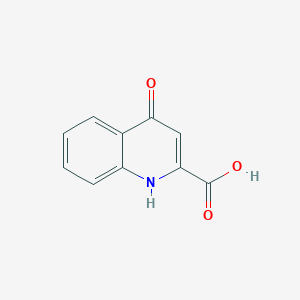| Full List of Protein(s) Regulating This Metabolite |
| Apolipoprotein (Apo) |
|---|
| Apolipoprotein A-II (APOA2) |
Click to Show/Hide the Full List of Regulating Pair(s): 1 Pair(s)
|
| Detailed Information |
Protein Info
 click to show the details of this protein click to show the details of this protein
|
| Regulating Pair |
Experim Info
 click to show the details of experiment for validating this pair click to show the details of experiment for validating this pair
|
[2] |
| Introduced Variation |
Mutation (-265T >C(rs5082)) of APOA2 |
| Induced Change |
Kynurenic acid concentration: decrease (FC = 0.80) |
| Summary |
Introduced Variation

 Induced Change
Induced Change

|
| Disease Status |
Obesity [ICD-11: 5B81]
|
| Details |
It is reported that mutation (-265T >C(rs5082)) of APOA2 leads to the decrease of kynurenic acid levels compared with control group. |
| GPCR secretin (GPCR-2) |
|---|
| Glucagon receptor (GCGR) |
Click to Show/Hide the Full List of Regulating Pair(s): 1 Pair(s)
|
| Detailed Information |
Protein Info
 click to show the details of this protein click to show the details of this protein
|
| Regulating Pair |
Experim Info
 click to show the details of experiment for validating this pair click to show the details of experiment for validating this pair
|
[3] |
| Introduced Variation |
Knockout of Gcgr |
| Induced Change |
Kynurenic acid concentration: decrease (FC = 2.3) |
| Summary |
Introduced Variation

 Induced Change
Induced Change

|
| Disease Status |
Type 2 diabetes mellitus [ICD-11: 5A11]
|
| Details |
It is reported that knockout of GCGR leads to the decrease of kynurenic acid levels compared with control group. |
| Hydrolases (EC 3) |
|---|
| Leukotriene-C4 hydrolase (GGT1) |
Click to Show/Hide the Full List of Regulating Pair(s): 1 Pair(s)
|
| Detailed Information |
Protein Info
 click to show the details of this protein click to show the details of this protein
|
| Regulating Pair |
Experim Info
 click to show the details of experiment for validating this pair click to show the details of experiment for validating this pair
|
[4] |
| Introduced Variation |
Knockdown (siRNA) of GGT1 |
| Induced Change |
Kynurenic acid concentration: increase |
| Summary |
Introduced Variation

 Induced Change
Induced Change

|
| Disease Status |
Renal cell carcinoma [ICD-11: 2C90]
|
| Details |
It is reported that knockdown of GGT1 leads to the increase of kynurenic acid levels compared with control group. |
| Transcription factor (TF) |
|---|
| R2R3-MYB (AN2) |
Click to Show/Hide the Full List of Regulating Pair(s): 1 Pair(s)
|
| Detailed Information |
Protein Info
 click to show the details of this protein click to show the details of this protein
|
| Regulating Pair |
Experim Info
 click to show the details of experiment for validating this pair click to show the details of experiment for validating this pair
|
[5] |
| Introduced Variation |
Overexpression of AN2 |
| Induced Change |
Kynurenic acid concentration: decrease (FC = 0.24) |
| Summary |
Introduced Variation

 Induced Change
Induced Change

|
| Disease Status |
Healthy individual
|
| Details |
It is reported that overexpression of AN2 leads to the decrease of kynurenic acid levels compared with control group. |
|
|
|
|
|
|
|
 click to show the details of this protein
click to show the details of this protein
 click to show the details of experiment for validating this pair
click to show the details of experiment for validating this pair
 click to show the details of this protein
click to show the details of this protein
 click to show the details of experiment for validating this pair
click to show the details of experiment for validating this pair
 click to show the details of this protein
click to show the details of this protein
 click to show the details of experiment for validating this pair
click to show the details of experiment for validating this pair
 click to show the details of this protein
click to show the details of this protein
 click to show the details of experiment for validating this pair
click to show the details of experiment for validating this pair
 click to show the details of this protein
click to show the details of this protein
 click to show the details of experiment for validating this pair
click to show the details of experiment for validating this pair

